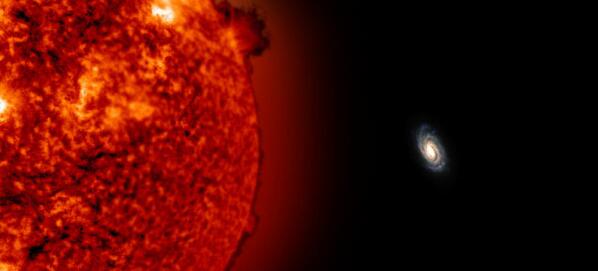We reach more than 65,000 registered users in Dec!! Register Now

Astronomers detect the farthest known star of Milky Way
- July 11, 2014
- 864 Views
- 0 Likes
- 0 Comment
The dis≠tant out≠skirts of our gal≠axy har≠bor val≠u≠a≠ble clues for un≠der≠stand≠ing its forma≠t≠ion and ev≠o≠lu≠tion. But the stars out there are few, far be≠tween, and far, far away. Now, as≠tro≠no≠mers are re≠port≠ing the dis≠cov≠ery of two stars in this dis≠tant "ha≠lo" that are the fur≠thest ev≠er dis≠cov≠ered in our gal≠axy, the ...
The dis≠tant out¬≠skirts of our gal¬≠axy har¬≠bor val¬≠u¬≠a¬≠ble clues for un¬≠der¬≠stand¬≠ing its forma¬≠t¬≠ion and ev¬≠o¬≠lu¬≠tion. But the stars out there are few, far be¬≠tween, and far, far away.
Now, as¬≠tro¬≠no¬≠mers are re¬≠port¬≠ing the dis¬≠cov¬≠ery of two stars in this dis¬≠tant ‚Äúha¬≠lo‚ÄĚ that are the fur¬≠thest ev¬≠er dis¬≠cov¬≠ered in our gal¬≠axy, the Milky Way, and are be¬≠ing de¬≠scribed as pos¬≠si¬≠ble ghosts of ga¬≠lax¬≠ies past.
They're so far away that if you could stand on them and look up to the sky, you'd see the entire Milky Way spi­ral out there, not just a small part of it, as we see from Earth.
As¬≠tro¬≠no¬≠mers led by John Bo¬≠chan¬≠ski, a vis¬≠it¬≠ing as¬≠sis¬≠tant pro¬≠fes¬≠sor at Hav¬≠er¬≠ford Col¬≠lege in Penn¬≠syl¬≠vania, were tar¬≠get¬≠ing stars in this ‚Äúha¬≠lo,‚ÄĚ a sparse shroud of stars that sur¬≠rounds the flat¬≠ter, spir¬≠al disk of our gal¬≠axy. The ha¬≠lo stretches to at least half a mil¬≠lion light years away. A light-year is the dis¬≠tance light trav¬≠els in a year.
Pre­vi­ously, only sev­en stars were known be­yond 400,000 light years.
Bochan¬≠ski and col¬≠leagues pub¬≠lished a let¬≠ter July 3 in the jour¬≠nal¬†As¬≠t¬≠ro¬≠phys¬≠i¬≠cal Jour¬≠nal Let¬≠ters¬†de¬≠tail¬≠ing the dis¬≠cov¬≠ery of the two stars, clas¬≠si¬≠fied as ‚Äúcool red gi¬≠ants‚ÄĚ cat¬≠a¬≠logued as ULAS J0744+25 and ULAS J0015+01.
They lie an es¬≠ti¬≠mat¬≠ed 775,000 and 900,000 light years away, re¬≠spec¬≠tive¬≠ly. To put it in per¬≠spec¬≠tive, when light from the fur¬≠ther star left the ob¬≠ject, ‚Äúour early hu¬≠man an¬≠ces¬≠tors were just start¬≠ing to make fires here on Earth,‚ÄĚ Bo¬≠chan¬≠ski said.
Red gi¬≠ant stars are rare com¬≠pared to near¬≠by ‚Äúcool red dwarf‚ÄĚ stars, but are nearly 10,000 times brighter, and thus more vis¬≠i¬≠ble. Us¬≠ing a com¬≠bina¬≠t¬≠ion of fil¬≠ters high¬≠light¬≠ing dif¬≠fer¬≠ent com¬≠po¬≠nents of the light from these gi¬≠ants, the team iden¬≠ti¬≠fied cool red gi¬≠ant can¬≠di¬≠dates from sur¬≠veys, then con¬≠firmed the find¬≠ings us¬≠ing the 6.5m tel¬≠e¬≠scope at the MMT Ob¬≠serv¬≠a¬≠to¬≠ry on Mt. Hop¬≠kins in Ar¬≠i¬≠zo¬≠na.
‚ÄúIt is re¬≠mark¬≠a¬≠ble to find stars this far out in the Milky Way gal¬≠axy,‚ÄĚ said Dan¬≠iel Ev¬≠ans, lead for In¬≠di¬≠vid¬≠ual In¬≠ves¬≠ti¬≠ga¬≠tor Pro¬≠grams at the U.S. Na¬≠t¬≠ional Sci¬≠ence Founda¬≠t¬≠ion's Di¬≠vi¬≠sion of As¬≠tronomical Sci¬≠ences, which funded the re¬≠search. ‚ÄúThese re¬≠sults will un¬≠doubtedly shed new light on the forma¬≠t¬≠ion and ev¬≠o¬≠lu¬≠tion of our ga¬≠lac¬≠tic home.‚ÄĚ
The stars' sig­nif­i­cance goes be­yond their record-holding dis­tances be­cause they in­hab­it the ha­lo, the as­tro­no­mers said. Some as­tro­no­mers think that the ha­lo is like a cloud of ga­lac­tic crumbs, the re­sult of the Milky Way's merg­er with smaller ga­lax­ies over our gal­ax­y's life­time, said Hav­er­ford Col­lege as­tron­o­mer Beth Will­man, a co-author of the stu­dy.
‚ÄúThe¬≠ory pre¬≠dicts the pres¬≠ence of such an ex¬≠tend¬≠ed stel¬≠lar ha¬≠lo, formed by the de¬≠stroyed re¬≠mains of small dwarf ga¬≠lax¬≠ies that merged over the cos¬≠mic ages to form the Milky Way it¬≠self,‚ÄĚ Will¬≠man said. ‚ÄúThe prop¬≠er¬≠ties of cool red gi¬≠ants in the ha¬≠lo thus pre¬≠serve the forma¬≠t¬≠ion his¬≠to¬≠ry of our Milky Way. These stars are truly ghosts of ga¬≠lax¬≠ies past.‚ÄĚ
Source : world-science.net









